|
Home Who Can Play Where is it Played The Gear The Official Rules The Picture Gallery The T-Shirt The Video Related Sites E-mail us at: underwaterfootball@ underwaterfootball.com |
|
This site is maintained by: Sean Ennis Contributed to by |
The Gear - Personal Equipment
To play Underwater Football you need the following equipment:- Mask
- Fins
- Snorkel
- Swimsuit
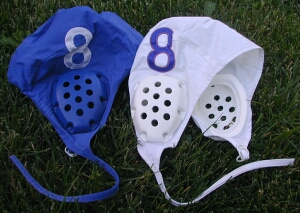 We also recommend that you wear a water-polo cap.
Most teams will be able to provide you with one;
however, individual players may want to have their own.
Not only does it help identify which team you are on,
it acts as a form of ear protection.
It doesn't happen often,
but as our cousins (the Underwater Hockey players) have
learned - a fin hitting you in the ear is an excellent way to get a burst ear drum.
We also recommend that you wear a water-polo cap.
Most teams will be able to provide you with one;
however, individual players may want to have their own.
Not only does it help identify which team you are on,
it acts as a form of ear protection.
It doesn't happen often,
but as our cousins (the Underwater Hockey players) have
learned - a fin hitting you in the ear is an excellent way to get a burst ear drum.
Most of the time we can scrape up enough spare gear from the other players to give a new person a chance to experience the game. Very soon after you start you will discover that you want your own equipment. You don't have to go out to a scuba diving shop and spend $400.00 on equipment. You can start with a $20 mask & snorkel set and fins from one of the big-box retailers (e.g., Whatever-Mart) or a general sporting goods store. From there, you can start upgrading your equipment as you gain experience and to suit your own particular tastes. Here are some recommendations about how to find the best equipment for you: |
Mask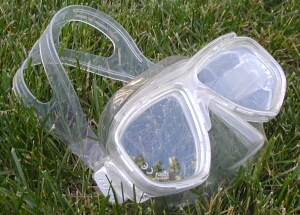 The mask is the most important piece of your gear.
It has to fit properly or you are going to get water in your mask
and you won't be able to see.
Price is not the biggest consideration in which mask you choose.
A $20 mask will sometime fit better than a $140 mask.
The mask is the most important piece of your gear.
It has to fit properly or you are going to get water in your mask
and you won't be able to see.
Price is not the biggest consideration in which mask you choose.
A $20 mask will sometime fit better than a $140 mask.
You can check the fit by holding the mask on your face without putting the strap on the back of your head. If you inhale slightly through your nose and let go of the mask, it should stay on your face. If not, it is either too big or too small. For a sport like Underwater Football, you want a mask that is low volume and has a low profile. This will generally give you a wider field of view (all masks will restrict your vision, even more so when you are underwater). The low profile will also lessen the chances of having your mask accidentally dislodged when you are playing. Skip the gadgets. Side windows and a water purge in the nose piece are not worth the hassle. They are an extra, unneeded point of failure and don't offer very much benefit (except perhaps to increase the price of the mask). The only extra piece that I would consider are prescription lenses. If you have particularly bad eyesight, you may want to consider them. Some people can get away with wearing contact lenses. However, when you flood your mask, you stand a good chance of losing them, so you should use disposable contact lenses. |
Fins
There are two basic types of fins: Open-heeled and Closed-heeled (or full-foot).
Open-Heeled Fins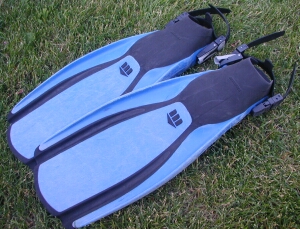 Open-heeled fins have three parts: the fin (or blade), the foot pocket,
and the strap.
Most people do not play with them and some places have banned them outright.
There are some concerns about possible injuries from the buckles on the fin
straps.
Open-heeled fins have three parts: the fin (or blade), the foot pocket,
and the strap.
Most people do not play with them and some places have banned them outright.
There are some concerns about possible injuries from the buckles on the fin
straps.
They are most often used for SCUBA diving, because they will fit over a neoprene boot or a dry-suit boot. They are generally very stiff, as they are designed to propel a diver who is carrying a 40 lb. air tank, lead weights, and other gear. They are like the tractor on a semi. Not very efficient for driving to the store; however, they can haul the heaviest of loads. They are also more expensive than a closed heal fin as they are very specialised and generally only found in a SCUBA diving shop. They also require a pair of neoprene boots (an extra expense). There are some he-man players out there who claim you don't need boots, but unless you have toes like a ballet dancer you will want to wear the boots. |
Closed-Heeled Fins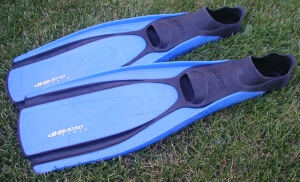 If an open-heeled fin is like the tractor on a semi,
the close-heeled fins are like a sports car: light and manoeuvrable.
They are simpler and have only two parts: the fin (or blade) and foot pocket.
They are not as stiff as an open-heeled fin.
You can get these fins almost anywhere.
They start at around $20 and go up from there.
If an open-heeled fin is like the tractor on a semi,
the close-heeled fins are like a sports car: light and manoeuvrable.
They are simpler and have only two parts: the fin (or blade) and foot pocket.
They are not as stiff as an open-heeled fin.
You can get these fins almost anywhere.
They start at around $20 and go up from there.
As with the masks, skip the gadgets. There are a lot of specialised fins on the market. Some of them are split down the middle. Some of them are very short and require a specialised kick. Some of them have special flaps and hinges. They are all meant to be "the fastest and most efficient fin on the market". In reality the performance gains and speed make very little difference to most people and probably are not worth the cost. It you are in the top 10% of swimmers and you want that extra edge, they may be appropriate for you. However; most people will get more out of some extra practise with the fins along with a physical training program. |
Snorkel
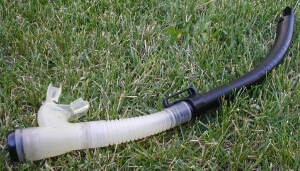 Your snorkel should be simple and have a soft mouthpiece.
A simple J-tube snorkel should be enough to get you started,
and it will make you a better player and snorkeller.
Your snorkel should be simple and have a soft mouthpiece.
A simple J-tube snorkel should be enough to get you started,
and it will make you a better player and snorkeller.
Avoid a rigid mouthpiece an accidental kick (or catching the ball with your face) could mean a trip to the dentist. A flexible mouthpiece will act a lot like a mouth guard that you would use in a contact sport like Football (American/Canadian), Rugby, or Hockey. You may also be able to find some specialised snorkels that have a proper mouth guard built in.
Does my snorkel have a tube with a big enough diameter? The rule of thumb for this is "your thumb should be able to fit in the end of the snorkel". If it does not, then it is too small and you'll get too much resistance when you try to breathe through it. You can do it, but why try to breath through a straw when there is something better out there.
Again, skip the gadgets. You do not need a purge valve in the snorkel, nor do you need anything on the end of it to keep water out. The purge valve will probably mean that you have a rigid mouthpiece, which is a bad thing. Anything on the end of the snorkel to keep it dry will just add resistance to your breathing. Get used to the fact that you are going to get water in your snorkel (whether you have a dry, super-dry, ultra-dry, hyper-dry, or super-colossal-dry snorkel). Again, a simple J-tube snorkel should be enough to get you started. It will make you a better player and snorkeller.
Swimsuit
Your swimsuit should be of sturdy construction and fit comfortably. Some people also prefer to wear two at a time as this offers them a little more modesty. There are some different considerations for men and women.Men
Brief style swimsuits (generally spandex) tends to offer less resistance in the water than the trunks style of suit. However, many men do not have the body shape that suits this kind of swim suit and they may not feel comfortable wearing them swimming.The trunks style of swimsuits tends to have a little more drag than the brief style, but it is somewhat more modest than the brief style.
Women
Most women choose to wear a one piece sports swimsuit (racer-back or cross-back). A two piece (or bikini style) swimsuit is not recommended. Underwater Football is a contact sport, and they offer the potential that one or more pieces will be dislodged or lost.The Gear - Everything Else
The remaining gear that you need is:- The Ball
- Survey Marking Tape
- A Deep Pool
- A Diving Ring
The Ball
The ball we use to play with was constructed out of a pneumatic ball about 8 inches (20 cm) in diameter. Generally a hand ball or a child-sized basketball will do. The pebbling on the ball needs to be sanded off so that it will fly straight in the water.To make the ball sink, it is emptied of air and filled with a liquid that will make it heavier than water. We have had some success with VERY salty water; however, we have had the most success with corn syrup. The preferred method is to fill it using a large volume syringe with a ball filling needle attached to the end of it. The procedure is as follows:
- Remove the plunger from the syringe.
- Insert the needle into the ball and reduce the air pressure in it to the ambient level (make the ball soft).
- Heat the corn syrup until it flows easily (be careful, it will probably be very hot).
- Ladle the corn syrup into the barrel of the syringe.
- Insert the plunger back into the syringe and push the syrup into the ball.
- Remove the plunger from the syringe (without taking it out of the ball). This will remove a little more air from the ball.
- Fill the syringe again and repeat the process until the ball is full of corn syrup.
Obtaining the syringe is left as an exercise to the reader. This is where it pays off to have a good relationship with your doctor or veterinarian.
Survey Marking Tape
Survey marking tape is used to identify the players. A length of it is tied around the wrists and ankles to identify to which team a player belongs. It is cheap and can be obtained in large quantities and several different colours. Each team can be identified with different colours of tape, or one team may choose to wear no tape at all.A Deep Pool
Generally the deep end of a community or public swimming pool will be sufficient to play. The ideal pool is 10 metres by 15 metres, and 4 metres deep. The short side is normally used as the goal line.You will need to mark the goal area on the side of the pool. If you have been playing in the pool for a long time, you might be able to convince the maintenance staff to mark the pool sides in a permanent way (e.g., with stripe of paint or by replacing some of the tiles with the accent colour). If not, you will have to improvise. There may even be "natural" marks on the edge of the pool you can use to define the goal area.
You should also consider liability insurance. Who's are you playing under? Your pool's? Your school's? Your club's? Your dive store's? Your own? None? Most public pools will not let you play without having some sort of insurance. Even if they do, you should probably consider getting some insurance.
Diving Ring
Invariably, the pool that you use will have a bottom that slopes slightly towards the drains. To keep the ball from rolling away from the centre of the playing area during the face-off, you will need to place it on a diving ring (or a similar device).A diving ring is a doughnut shaped object, normally made of plastic. It needs to be big enough to securely hold the ball in place until the game starts. Most public pools will have several. You should also be able to get them at any pool supply store or big-box retailer.
 Home
Home